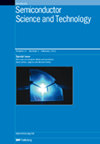Subject coverage. Experimental and theoretical studies of the structural, electrical, optical and acoustical properties of bulk, low-dimensional and amorphous semiconductors; computational semiconductor physics; interface properties, including the physics and chemistry of heterojunctions, metal-semiconductor and insulator-semiconductor junctions; all multi-layered structures involving semiconductor components. Dopant incorporation. Growth and preparation of materials, including both epitaxial (e.g. molecular beam and chemical vapour methods) and bulk techniques; in situ monitoring of epitaxial growth processes, also included are appropriate aspects of surface science such as the influence of growth kinetics and chemical processing on layer and device properties. Physics of semiconductor electronic and optoelectronic devices, including theoretical modelling and experimental demonstration; all aspects of the technology of semiconductor device and circuit fabrication. Relevant areas of 'molecular electronics' and semiconductor structures incorporating Langmuir- Blodgett films; resists, lithography and metallization where they are concerned with the definition of small geometry structure. The structural, electrical and optical characterization of materials and device structures. Materials and device reliability: reliability evaluation of technologies; failure analysis and advanced analysis techniques such as SEM, E-beam, optical emission microscopy, acoustic microscopy techniques; liquid crystal techniques; noise measurement, reliability prediction and simulation; reliability indicators; failure mechanisms, including charge migration, trapping, oxide breakdown, hot carrier effects, electro-migration, stress migration; package- related failure mechanisms; effects of operational and environmental stresses on reliability. Papers will normally be categorized under one of four headings: electrical and optical properties, devices, crystal growth and materials, and reliability.
